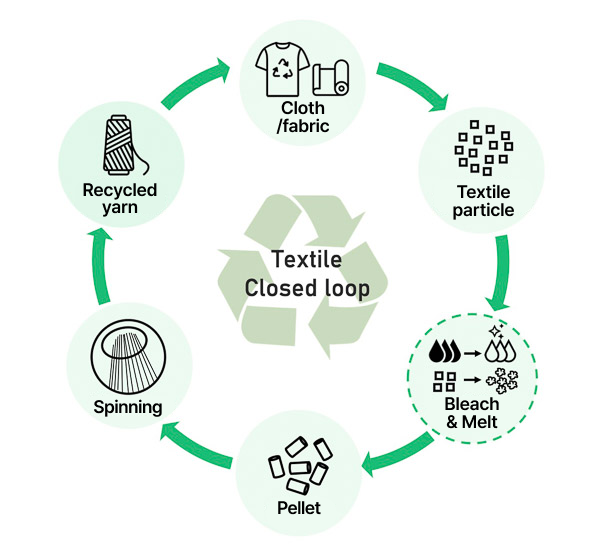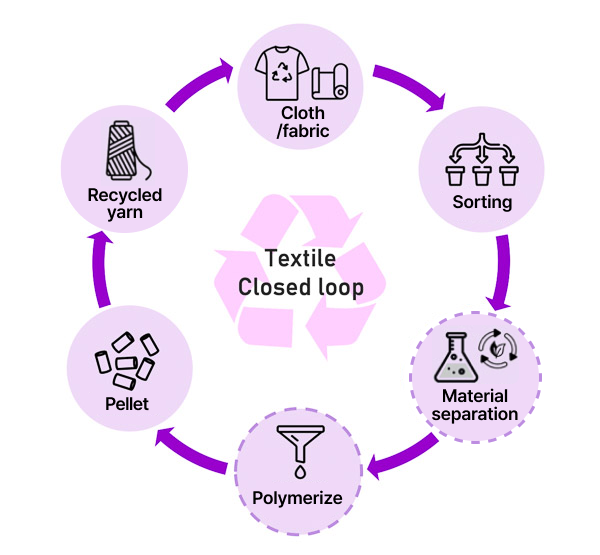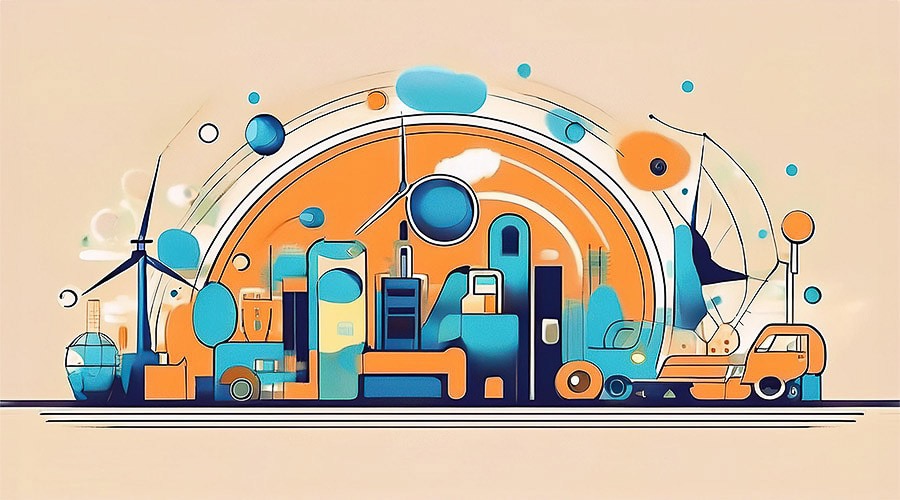Content content
Would you believe it if someone told you there are cows that eat clothes? This is precisely the situation in Ghana, Africa. Ghana is one of the main importers of second-hand clothing from around the world. According to the U.S.-based NGO, OR Foundation, about 15 million pieces of second-hand clothing are imported into Ghana every week. However, approximately 40% of these clothes are not resold or reused and end up as waste. As a result, cows that should be grazing on the vast grasslands are eating discarded clothes as if they were fodder, and the Odaw River, once a source of drinking water, has long been polluted by textile waste.
The Fashion Industry's Shift to Sustainable Clothing in Response to the Climate Crisis
With the rise of fast fashion, clothing production has increased rapidly. Nowadays, consumers are buying more clothes at lower prices but are also discarding them just as quickly. According to ‘A Study on the Measures Used to Improve Old Clothes Disposal,’ approximately 100 million tons of clothing are produced globally each year, yet only about 15% of it is recycled. Of the remaining 85%, about 75% is incinerated or sent to landfills, contributing significantly to air and soil pollution.

▲ A t-shirt made from Hyosung TNC's recycled fibers
The fashion industry has become more aware of the downsides of fast fashion and is making various efforts to mitigate these side effects. Examples include recycling clothing waste by extracting raw materials to create new products, or upcycling, which repurposes old materials such as banners and seatbelts into new products like bags and wallets. Additionally, some are reducing waste and maximizing the use of limited resources by producing yarn for clothing from discarded fishing nets and plastics.
Among these efforts, garment recycling—a method of extracting yarn from discarded textiles to create new fabrics or garments—is gaining attention. This method is particularly promising because it allows for the recycling of discarded clothing that would otherwise be incinerated or landfilled due to technical challenges such as dye removal, seam and label separation. As a result, global clothing brands are increasingly attempting to incorporate garment recycling into their production processes.
As a representative example, H&M launched the "Garment Collecting" initiative in 2013, collecting unworn clothing and fabric products from households at H&M stores for recycling and reuse. Notably, last year, they introduced the garment-to-garment recycling system called "Looop" in Sweden, which utilizes technology to deconstruct and reassemble used clothing. The clothes fed into the Looop machine are washed, shredded, and transformed into new yarn, which is then used to create fashion items.
ZARA’s "Renewcell × ZARA Capsule Collection" is made from viscose fabric produced using yarn extracted from discarded jeans and leftover materials generated during clothing production. This process recycles wasted fibers, reducing carbon emissions and textile waste while minimizing the consumption of wood pulp required for fabric production, thereby lessening its environmental impact.
HYOSUNG’s Advanced Commitment: Dreaming of Zero Clothing Waste through Garment Recycling
Garment recycling is expected to significantly reduce clothing waste that has historically gone unrecycled. Hyosung TNC has long been researching garment recycling to maximize resource circulation. As a result, the company showcased products incorporating this technology during Seoul Fashion Week. One such sustainable fiber technology introduced by HYOSUNG, "Textile to Textile," retrieves fiber waste generated during the clothing manufacturing process and transforms it back into yarn.

▲ A Circular System of Physical Resource Recycling
The "Textile to Textile" method recycles discarded textiles using both physical and chemical methods to produce yarn. The physical resource recycling approach collects 100% PET and nylon waste textiles and garments, which are crushed and then melted for regeneration. This method minimizes chemical and thermal processing compared to other recycling methods, resulting in excellent carbon reduction capabilities during the process. However, the resources that can be regenerated through melting are limited.

▲ A Circular System of Chemical Resource Recycling
The chemical resource recycling method involves separating and sorting blended fabric and garments, followed by pre-treatment at the polymer level and the separation of materials. This process ultimately yields high-quality recycled yarn through the regeneration of raw materials, even allowing to produce yarn that meets the same quality standards as original materials. In other words, it secures the physical properties of recycled products to the same level as the original products, making it an optimized approach for a circular economy. However, it requires advanced technology and poses significant cost challenges, making commercialization difficult. Nonetheless, continuous technological advancements are reducing the differences between physical and chemical recycling, leading to gradual commercialization.
Hyosung, in particular, possesses depolymerization technology for recycling nylon waste fishing nets, enabling chemical resource recycling for nylon garments. Depolymerization refers to the process of reversing polymerization in plastics through the application of chemicals or heat. Essentially, it means returning plastics to their raw material stage through chemical decomposition. A key advantage of this process is the ability to purify materials during dissolution, allowing for the separation of additives, colors, and contaminants. By applying this technology, even waste textiles that were previously deemed difficult to recycle can be transformed into new yarn.
Collaborating with Sustainable Fashion Brands

▲ PLETS MAMA’s Saddle bag, made through a Collaboration with Hyosung TNC
HYOSUNG is actively collaborating with various clothing brands utilizing its "Textile to Textile" technology. One notable project is the ‘Rewind’ initiative with the sustainable fashion brand PLEATS MAMA, which signifies the transformation of waste fabrics into new creations. In this project, Hyosung TNC processed 100% polyester waste fabric by applying heat to spin it into yarn, which was then transformed into chip form. These chips were extruded to create yarn for the "Saddle Bag" product. The Saddle Bag serves as an example of bringing new life to waste fabrics and realizing the value of resource circulation.

▲MONTSENU Products on Display at the 2025 S/S Seoul Fashion Week Showroom
In addition, since 2023, Hyosung TNC has been engaged in multiple collaborations with the fashion startup MONTSENU. MONTSENU produces yarn from discarded clothing and hotel linens through physical resource recycling and weaves this yarn into fabric for new products. During the 2025 S/S Seoul Fashion Week, MONTSENU showcased products such as hoodies, sweatshirts, t-shirts, and pants that incorporated garment recycling technology. This initiative garnered significant attention as it goes beyond mere recycling to create sustainable fashion by utilizing resources that would otherwise be wasted.
HYOSUNG’s Vision for the Next Step: Fashion Zero Waste
Hyosung TNC is a leading company in the production of chemical fiber materials, but it has also been dedicated to the development of sustainable textile materials from an early stage. Starting in 2007 with the world’s first regen Ocean Nylon, made from recycled fishing nets, HYOSUNG has successfully created regen Nylon from recycled waste yarn and chips, as well as regen Polyester from recycled clear PET bottles. Furthermore, the company developed regen Spandex from industrial waste and regen BIO Spandex, the first spandex made from chemicals derived from corn, demonstrating HYOSUNG’s sincere commitment to the future of fashion.
Recently, during the 2025 S/S Seoul Fashion Week, HYOSUNG conveyed its aspirations for a circular structure in fashion and a resource recycling system. Until the day when clothing waste generation reaches "zero," HYOSUNG will continue its research and challenges in developing recycling technologies that encompass the entire process—from fiber manufacturing to disposal and back to yarn regeneration. Committed to a future of the fashion industry where everyone can coexist, HYOSUNG will persist in driving innovation.










